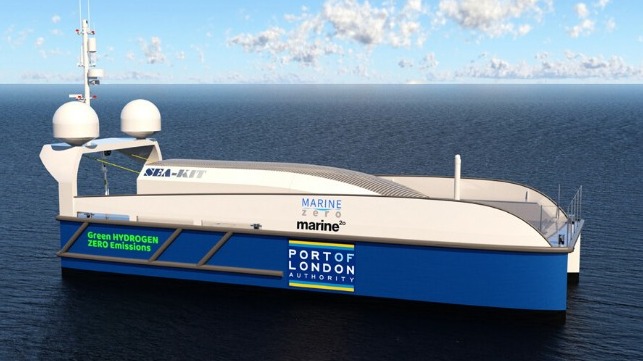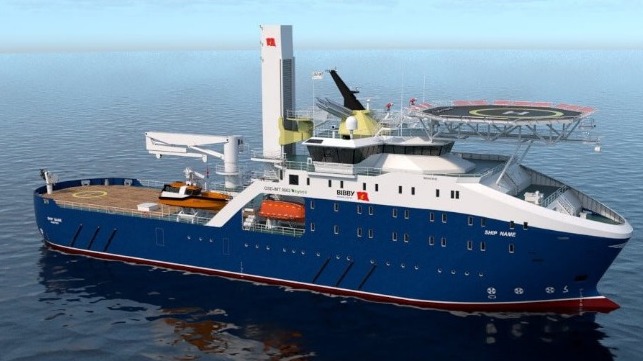UK Competition Funds Project for Hydrogen Fueling and USV Demonstrator

An innovative project involving the Port of London as one of the partners looks to develop a hydrogen infrastructure that will provide power for the future maritime industry. The project includes the development of the onshore infrastructure and would deploy an uncrewed surface vessel for surveys as the first vessel to employ the process.
The Port of London Authority (PLA), a consortium partner, will host the hydrogen refilling station on the River Thames in London and subsequently operate the ZEPHR USV. The two phases of the project focus on the design and integration of the dispensing facility which includes the land-based infrastructure to produce green hydrogen, via renewable energy and the electrolysis of water, as part of the project. The demonstration vessel will be developed by SEA-KIT International.
Dubbed ZEPHR - Zero Emissions Ports Hydrogen Refilling Survey Vessel, the project aims to extend vessel operation for port operators and stakeholders through complete energy transferal, from readily accessible green electricity to 100 percent green hydrogen production, compression, storage, and dispensing.
The project organizers highlight that the Thames is Britain's busiest inland waterway, handling over five million tonnes of goods and materials and millions of passengers each year. The Thames Estuary is, therefore, they contend well placed to support the development of a hydrogen ecosystem, with significant potential usage demand across several sectors, including ports, marine and river transportation, airports and aviation, construction, distribution, and logistics.
SEA-KIT says the configurable ZEPHR USV platform will have a high-resolution multibeam echosounder as its primary payload, with the capability to mount additional sensors such as LiDAR, cameras, and environmental monitoring and sampling equipment. The vessel will also be able to launch and recover aerial drones for surveying, surveillance, search and rescue. ZEPHR will use two hydrogen fuel cell systems for redundancy.
The vessel’s design will be reviewed with Lloyd’s Register and the Maritime and Coastguard Agency to satisfy regulatory and compliance requirements and to obtain approvals for continuous operations.
The five-year project is another of the proposals that was selected and will receive funding from the Zero Emissions Vessels and Infrastructure (ZEVI) competition. The UK is sponsoring the competition and providing funding for projects that will develop and demonstrate new technologies that contribute to the decarbonization of the maritime sector. The competition requires the winner to begin their demonstration by 2025.
UK Effort Plans First Electric SOV in Offshore Decarbonization Race

A coalition of leading maritime companies led by Bibby Marine and with financial support from the UK plans to develop the first zero-emission electric Service Operation Vessel (eSOV) to be used to support the offshore wind and energy industry. It is the latest entrant in the race to develop the first zero-emission vessels with a focus on the offshore sector and the potential of using power at the wind farms to charge the ships.
In their application for the UK’s Zero Emission Vessel Infrastructure (ZEVI) competition, the coalition points to the strong opportunities in the segment to support offshore wind operations. With the UK calling for 40 GW offshore wind energy in additional offshore wind energy capacity by 2030 expanding on the more than 10 GW already in operation, the group estimated that between 62 and 149 vessels will be required. They highlighted that all the UK-operating SOVs have so far been built aboard.
They are proposing a 295-foot vessel that would be primarily powered by electricity and batteries and have dual-fuel methanol-powered engines as backup. The ship will be ready for offshore charging and can recharge its batteries at night.
They expect that it will be possible to operate a two-week cycle onsite at an offshore wind farm emissions-free. Near shore the vessel will operate solely on battery power and also while onsite. For the long transits between the shore homeports and the farms, the vessel will use its engines and with methanol fuel, it would be possible to still reduce emissions by 90 percent versus fossil fuel operations. They noted in the application if offshore charging is not available, the vessel would use its methanol engines to recharge its batteries and would still achieve a 50 percent reduction in emissions compared to a conventional SOV.
DNV, which is one of the members of the coalition notes, “The number of fully electric and hybrid vessels will surge over the next few years, and continuing development on these technologies will be a key part of the maritime industry’s transition to a zero-carbon future.”
Bibby, which is leading the effort notes the vessel will be a natural progression in its decarbonization effort and the first new vessel for Bibby Marine in five years.
It was one of five projects that was announced today at London International Shipping Week as a winner in the UK Government’s competition designed to support the development of new zero-emission maritime technologies. Under the rules of the competition, the vessel needs to be in service by 2025.
They are estimating a cost of $37.5 million for the project with the UK government awarding them $25 million in funding. The project participants include Bibby Marine, Port of Aberdeen, Offshore Renewable Energy (ORE) Catapult, Kongsberg, DNV, Shell, and Liverpool John Moores University.
In the previous rounds of the funding competition, the UK has also awarded support to projects seeking to develop the technology required to provide offshore recharging capabilities. It has been highlighted that one of the challenges is the increasing distance from shore for the location of the wind farms, making onsite recharging critical. The UK projects are one of several looking at offshore recharging and creating vessels that are fully electric or use other technologies to be zero-emission ships.
No comments:
Post a Comment